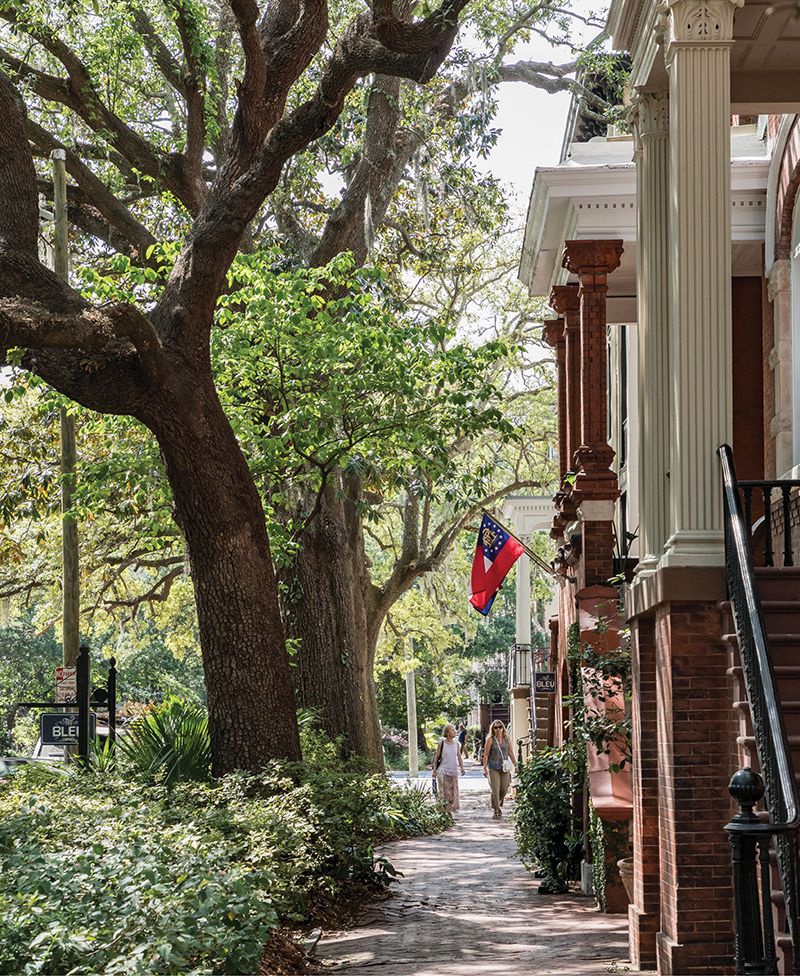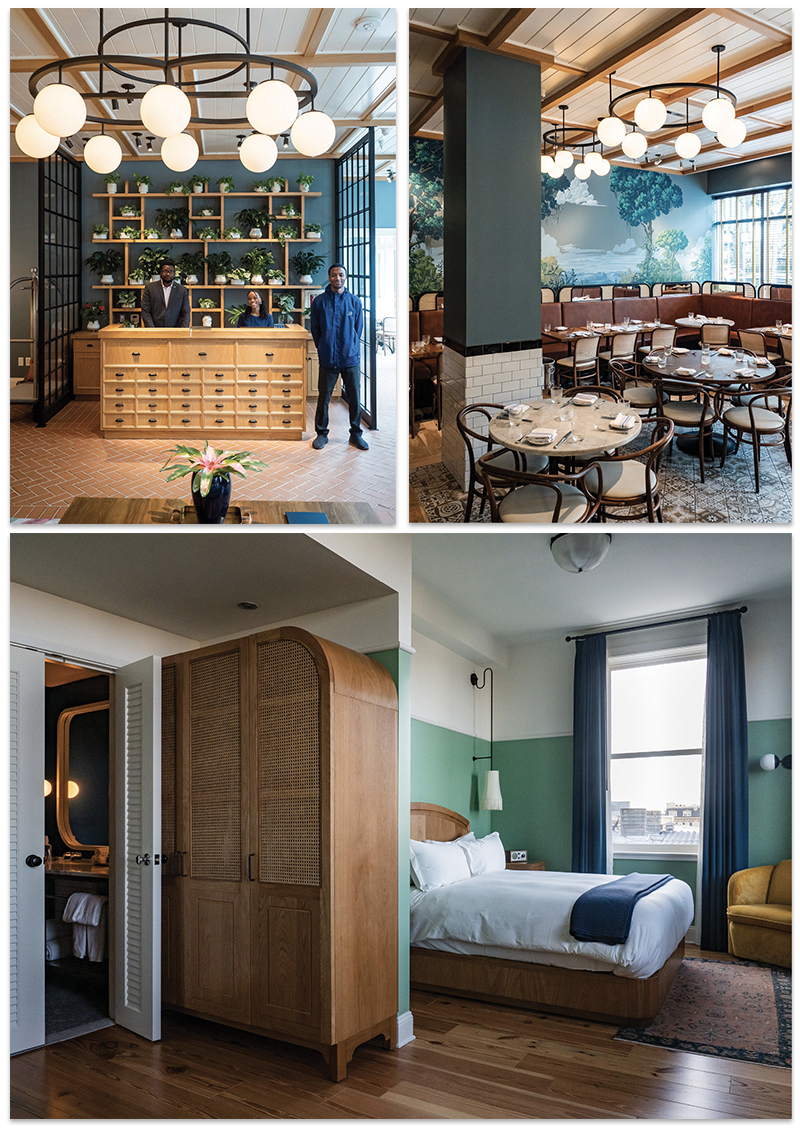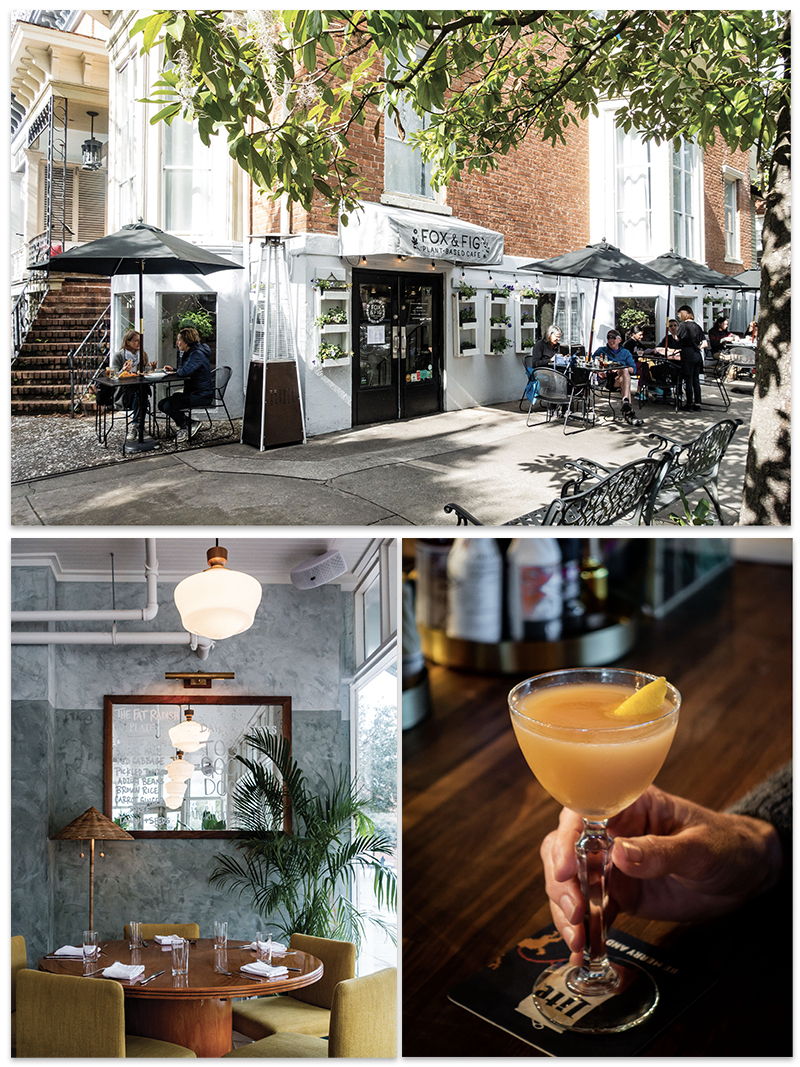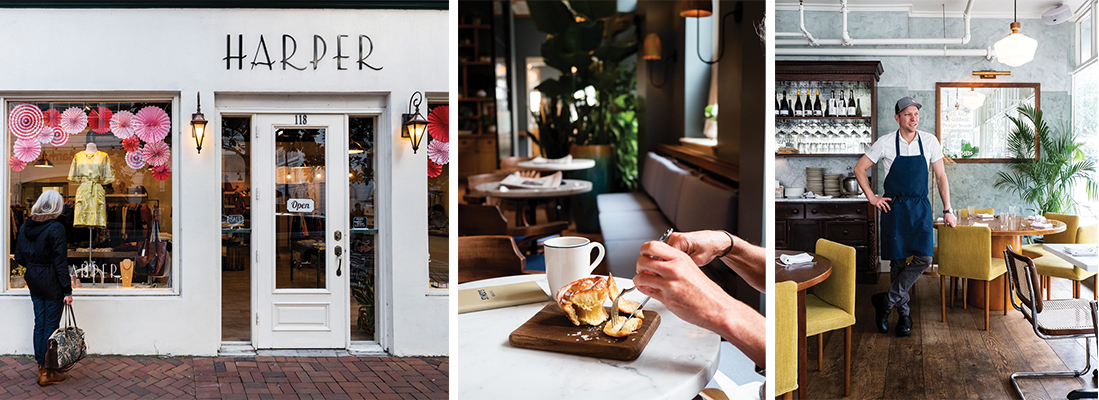Tag along on our weekend getaway and discover the new restaurants and bars, cool shops, and ever-expanding art scene

From a corner room on the fifth floor of the recently opened Drayton Hotel on Bay Street, a mammoth ship glides past along the Savannah River just down the bluff, creating an illusory slow-motion shift in the skyline. The stories-high stacks of primary-colored shipping containers appear to be slipping past within feet of the shimmering gold dome of Savannah City Hall—and at nearly the same height.
Here, the familiar is giving way to changes in the cityscape. Like Charleston, Savannah is having its own lodging boom—and a general flush of construction, renovations, and business openings. Even so, on the 100-mile drive down, mostly on Highway 17 South, there are still wide stretches of open grassland that gave this city her name. Seeing the green expanse is comforting, like visiting an old friend. Cross the river on the Talmadge Memorial Bridge into Georgia, and Savannah itself begins.
For a quick getaway to check out what’s new, we’re staying at The Drayton, a boutique hotel that’s among the latest to join the scene. It’s housed within a 19th-century bank building at the corner of Bay and Drayton streets in the heart of Savannah’s historic port buildings. Before the basement-to-rooftop renovation, the first floor was most recently occupied by an Outback Steakhouse. If you happen to remember that corner location, the interior is wholly transformed, beginning with the airy first floor lobby/lounge that’s decorated in a modern drawing room style with long couches, coffee tables arranged with art books, and cozy nooks.
But there are more than just new hotels in Savannah. Restaurants and bars are opening at a fast clip, too, and there’s much happening in the arts in the historic district as well as on the streets and blocks extending beyond the charms of the squares. Like those shipping containers slipping by and changing the view, it seems all of Savannah is in motion these days.

(Clockwise from top left) The front desk at The Drayton; murals in St. Neo’s Brasserie; and a fifth-floor guest room with downtown views
STATE OF THE ARTS
The morning I talk with Suzanne Jackson, whose artistic life was featured in a retrospective titled “Five Decades” last year at the Jepson Center—the contemporary art arm of the Telfair Museums—her assistants are combing through her studio archives for forgotten early sketches, including some dating back to the 1970s. “People are interested now,” Jackson says. “It’s wonderful.”
The 75-year-old artist, who was recently featured in The New York Times, is busy. She just sold out a winter show at Manhattan’s Ortuzar Projects and has been working on new pieces for her solo show this month at O-Town House in Los Angeles. Jackson, who’d lived in Alaska and California and had danced in a ballet troupe in South America, was prolific long before moving to Savannah in the 1990s to teach at the Savannah College of Art and Design (SCAD). She settled in and bought a house large enough for a studio in what’s now known as the “Starland District.”
“It was just so gorgeous, I took the job,” she says about first seeing the oak trees, historic squares, and old homes of Savannah. That was well before SCAD had developed dozens of properties downtown and the students had fanned out across the city to open studios, shops, and galleries of their own.
Jackson’s recent paintings include large, sculptural acrylic works that hang suspended without a canvas or a frame—and some pieces were part of a recent group show at Laney Contemporary Fine Art a few miles away. The rush of new attention in Savannah is a remarkable change of pace, she says: “Not many people came into the studio for about 20 years.”
Also in the Starland District, established in the early 2000s around the former Starland Dairy, we meet photographer Emily Earl, who helped to found the shared studio space Sulfur Studios. A venue for seeing and shopping for very fresh art, Sulfur’s gallery space is often hung with new pieces each week, Earl explains. Her own work includes a photo series of black-and-white images of late-night scenes and people in downtown Savannah that she’s made over the past eight years, walking along Congress Street between bars “from one end to the other, Whitaker to MLK” with one of her vintage Polaroid cameras and a stock of discontinued instant Fujifilm.
“Part of the success is that the camera is super sexy,” she says, lifting a 1970s model with bellows and a flashbulb extending from one side that she bought for $2 at a yard sale. Earl says she’ll continue her photography for the series into the summer—and she intends to use the last of her stockpiled film—just as her first solo show, “Late Night Polaroids” opens at the Jepson Center this June.
A NEW SPIN ON HISTORY
Back at the The Drayton, we meet owner Raghav Sapra, who says he knew at once that he’d found the right building. The Virginia-born, first-time hotelier had been learning the hospitality industry in New York for years when a friend and investor asked if he’d like to see an available late-1800s bank building in Savannah. Less than three years later, and after an extensive renovation that preserved exterior stone features and rebuilt the interior, the six-story hotel opened last fall with glossy, teal-colored wall tile in the elevator hallways, murals of Lowcountry scenery hand-painted by artist Bob Christian spanning dining room walls, and antique hardwood pine flooring salvaged from the original floor joists in all of the guest rooms.
Connecting the hotel to Savannah’s community today is a priority for Sapra, and he says that music is a particular passion. The young hotelier made sure that the floor plan included an intimate space for live music year-round in the Downstairs Cocktail Lounge, where jazz, blues, and folk musicians are often in the lineup and there’s a record player for spinning LPs, too.

(Clockwise from top) Cafe seating and vegan fare at Fox & Fig, cocktails at the Savoy Society, and a corner table at The Fat Radish
NYC TO MLK
We head out on the streets of the historic district on foot to explore the culinary scene. Savannah’s grid of thoroughfares, dotted by squares of public green spaces with pathways and monuments or fountains, is easy to navigate and always enticing you to keep going another block or two.
On past trips, we’ve had icy oysters in the bar at The Grey, watched the Bull Street passersby from brunch at The Collins Quarter, sipped cocktails downstairs at The Pink House, ordered fish on the saltwater creek-facing spit that’s home to The Wyld (a seven-mile drive from downtown), lined up for ice cream at the century-old Leopold’s, and tried many other longtime Savannah favorites. This time, we’re looking for new finds.
We’ve heard great things about the homemade dumplings at Flock to the Wok and stop in for a quick bite. The new Whitaker Street Asian-fusion spot resembles a bird cage, with brass bars separating the two dining spaces and bird motifs fluttering about on the staff uniforms and in the entryway floor tiles. The dumpling rumors are true: the doughy little purses filled with shrimp and vegetables are brought to the table quickly, along with a deliciously crunchy cucumber and coriander salad.
Later during happy hour, we walk to the new Savoy Society at the base of a mid-century apartment tower on East Liberty Street. In a corner space with tall glass exterior walls spanning two sides, there’s a cool, ’70s lounge vibe with rattan furniture and a long bar. LPs spin on a record player, and I order from a list of specials. The “Japanese Cocktail” of cognac, bitters, and orgeat (almonds and rosewater) arrives in a vintage coupe glass, and the bartender suggests what turns out to be a perfect high-low pairing to go with the elegant cocktail—one of the $1.50 bar snacks, a slider with Spam and pickled slaw on a toasted bun.
We also have an unhurried lunch at The Fat Radish, settling into the corner storefront interior with its bare woods, neutral colors, and abundance of plants. The setting and menu are immediately familiar because many of the same people who created Basic Kitchen in Charleston—and the original Fat Radish in Lower Manhattan—have been at work here. Ben and Kate Towill of Basic Projects in Charleston helped create the vision for the building on Martin Luther King, Jr. Blvd., just down the street from The Grey. (Upstairs are the maritime-stylish rooms of the Windrose Apartment Hotel, which they also designed.)
The fare at The Fat Radish is locally sourced and “vegetable forward” but also includes options such as roast chicken, fresh shrimp and oysters, and burgers served with duck-fat fries. Ensuring there are top-quality ingredients and something for everyone are the goals, says Chef Nick Wilber, who helmed the New York location and Basic Kitchen for a while—and his Savannah menus are just as creative.
“If you can miso-glaze salmon, why not a turnip?” he asks, explaining the thought process behind one of the daily specials. (The answer is that he did, and it’s excellent.) For another entree, Wilber roasts a whole hen-of-the-woods mushroom like a tenderloin steak and tops it with compound butter. The melty-tender orecchiette pasta and the shishito peppers with smoked soy sauce and sesame seeds are examples of the casually impressive dishes in which simple ingredients are allowed to shine. On our next visit, I want to try the roasted Georgia sweet potato topped with chili, kimchi aioli, and bonito flakes that I saw go out to several tables.
Before we leave, Chef Wilber asks if we’ve gotten to some of the city’s great art galleries. And just outside, a stream of couples and knots of people are following the sidewalks to the shops along Broughton, Congress, and Bull. That’s Savannah this trip and this new decade, I think while watching them—she’s in motion again.

(Left to right) Photographer Emily Earl; Laney Contemporary Fine Art; Windrose Apartment Hotel.
WHAT’S NEW, SAVANNAH?
A sampling of hot spots for staying and playing
Stay
Eat & Drink

(Left to right) Harper boutique on Bull Street; The Drayton Hotel; Chef Nick Wilber at The Fat Radish
Do
Shop